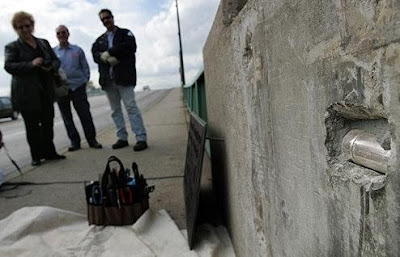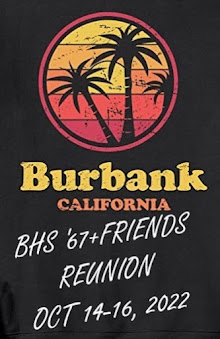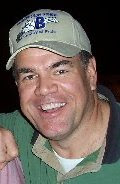Burbank city officials remove a 50-year-old miniature time capsule that was encased in concrete in the Magnolia Bridge in 1959. (Bob Chamberlin / Los Angeles Times)

Burbank unearths 50-year-old time capsule
1:21 PM, February 5, 2009
source
With a hammer and chisel, a Burbank city worker this morning carved out a tiny silver time capsule 50 years after it was first tucked into the base of the Magnolia Bridge.
"It was there -- we found it," said deputy city manager Joy Forbes, excitement and relief bubbling through her voice.
City officials did not know the capsule was due to be opened on Feb. 5, 2009, until Larry Harnisch at the Times' Los Angeles history blog e-mailed them over the weekend. City workers hustled to find the location of the time capsule. When they pried off the dedication plaque on the base of the bridge, near 1st Street and Magnolia Boulevard, they found a darker patch of cement.
Around 10:30 this morning, city officials gave the hammer and chisel to Stan Lynch, a 64-year-old Burbank resident who was there in 1959 when the capsule and bridge were dedicated. Lynch said he walked the half-mile from his house to the dedication ceremony 50 years ago because, frankly, "There wasn't a lot to do back in 1959."
He noted that a few things have changed in the area: The department store Burcal and several camera shops have closed. Obviously, the mall is new. But, he added, "Strangely enough, the feel of the city, the small-town feel Burbank always had, it's still there."
Lynch, an adult school substitute teacher in Burbank, said he had been telling people for years that there was a time capsule buried in that bridge. City officials said they didn't know there was one. His friends didn't believe him. So when he handed over the hammer and chisel to a city public works employee and watched him carve out the capsule, about the size of a can of soda, he felt vindicated.
"They talked about maybe putting a capsule in there to replace it and opening it in another 50 years," Lynch said. "I hope to be able to see that."
The 1959 Times blurb said the silver-plated lead capsule contained "35-mm films of various buildings, schools and the new city golf course." Burbank officials plan to take the capsule to a professional imaging and film lab next week to be opened. Forbes said they want to make sure a specialist can repair the film if time has damaged it. Prints could be made by the end of the month.
"It looks to be in good condition," she said, noting that the city has at least two other time capsules and plans to keep better track of when they're due to be opened.
-- Jia-Rui Chong
--- end ---
Historic capsule likely has Burbank views
By Tony Castro, Staff Writer
Updated: 02/05/2009 11:18:37 PM PST
source

Burbank Mayor Dave Golonski holds a time capsule at the east side of the Magnolia Bridge at 1st Street in Burbank, Feb. 5, 2009. The silver-plated lead capsule was sealed in the bridge in 1959 and contains 35-mm film of local buildings. (Hans Gutknecht/Staff Photographer)
BURBANK - Fifty years ago, Burbank city fathers planted a time capsule, which their modern day counterparts have spent a week searching for.
But after finally finding it Thursday behind a plaque at the foot of the Magnolia Boulevard Bridge, they'll still need a few more days to see what's inside. The capsule was nothing more than a silver-color 35mm film canister, whose contents are now being developed.
The dozen or so city officials, workers and residents who showed up for the unearthing were not so much disappointed as relieved.
"Yesterday we were all talking about how they were going to open this up and there would be nothing," said Rob Wendlandt, the city's facilities maintenance manager.
At the time, the city officials who planted the capsule predicted that in 2009, Burbank would be a community of 150,000 served by monorail transit and atomic power.
Fittingly, one of those who helped dig out the time capsule was Stan Lynch, a Burbank schools substitute teacher, who as a 14-year-old student had witnessed it being embedded in concrete along a railing of the bridge.
The bridge was new at the time, having cost $1.4 million, and Burbank was a different place.
"We didn't have Circuit City, AMC Theaters or Sears," said Lynch, referring to the three recent landmarks at the nearby intersection of Magnolia Boulevard and First Street.
"And soon we won't have Circuit City," quipped a bystander, noting the big "Going out of business" sign adorning the bankrupt retailer's building behind the bridge.
The heavy midmorning traffic moving briskly through the intersection was proof that the city never got monorail, much less the atomic power or the population projection.
According to the latest U.S. Census Bureau report in December, the population of Burbank is 101,858.
"Burbank hasn't changed; not at all," said Mayor Dave Golonski. "We're virtually the same place. Still a great community. Small community. Small-town values. Small-town feel."
On Thursday morning, workers peeled away the last layer of concrete to unveil the time capsule.
"It looks like a lead pellet," said Golonski when he got a first glimpse at it.
"Maybe it just looked bigger when I was younger," said Lynch, who was the only witness of the original time capsule entombment present at Thursday's ceremony. "Maybe I didn't get a good look at it then."
The film in the capsule is supposed to contain photographs of various buildings, schools and a golf course, but no one will get a look at them for several days.
City officials said the film will be specially treated to prevent any damage before it is processed and the photographs printed and released.
"You don't know how many times over the years I've told friends, `Hey, there's a time capsule buried at the base of the bridge,' and they haven't believed me," said Lynch.
Lynch's 23-year-old son, Steven, who was among those photographing the event, grinned and nodded.
"That's what he's been saying," the younger Lynch said. "And it turned out to be true."
--- end ---
City unearths history
source

Burbank resident Stan Lynch and mayor Dave Golonski hold a time capsule that was placed in the Magnolia St. bridge in 1959. Lynch was present for the capsule's original placement in the bridge. (Photo by Tom Risen)
Mayor helps dig up a 50-year-old lead tube containing images of Burbank.
By Tom Risen
Published: Last Updated Friday, February 6, 2009 10:07 PM PST
Stan Lynch had a day off from school Feb. 5, 1959, and witnessed then-Mayor H.B. Jerry Bank install a time capsule behind a plaque on the newly built bridge on Magnolia Boulevard.
Lynch sat at the same site Thursday with his son Stephen Lynch and Mayor Dave Golonski to unearth a piece of history: a 50-year- old silver-plated lead tube containing images of Burbank buildings and golf courses from a bygone era. To the side of a closed-off lane on the Magnolia bridge, city officials gathered with a crowd of photographers to delicately extract the capsule from the concrete with a hammer and pick.
“It’s a good thing nobody ran into the bridge,” Lynch said as he and Golonski unearthed the capsule, hidden behind a plaque. “I feel vindicated because for years I would pass by here and tell my friends, ‘There’s a time capsule hidden behind that,’ and they’d all think I was crazy.”
The council was inspired to unearth the capsule after Larry Harnisch, who writes for the Los Angeles Times history blog, the Daily Mirror, found 50-year-old articles that commemorated the time capsule burial. The time capsule, according to the articles, was intended to be unearthed at precisely 11 a.m. Feb. 5, 2009.
Now in the possession of Deputy City Manager Joy Forbes, the capsule will be given to Warner Bros. for safe development of the historic archive.
“Because we know it contains film, we hope they can help us salvage it in case there’s been any damage,” Forbes said. “We should have some photos at the end of the month.”
While the economy has changed after 50 years, Burbank’s population has stayed around 100,000 residents. The capsule predicted Burbank of 2009 would have 150,000 inhabitants, nuclear power and a monorail, according to a 1959 article of the Los Angeles Times.
“The city really, as far as having a small-town feel, I don’t think has changed,” Lynch said. “The old buildings disappeared and got replaced by new stuff. Behind the bridge was the ‘99 building’ of offices, and they tore that down. Now it’s a Circuit City, and they might tear that down now too.”
There were already film studios in 1950s Burbank, but the shutdown of Lockheed’s manufacturing plants by the end of the 1980s has changed the city the most, Lynch said.
“When I was 14, it wasn’t unusual for 75% of the classmates to have family that worked for Lockheed,” he said. “The mall on Magnolia Boulevard is the biggest change after that. We finally got a mall.”
Back in the 1950s, without malls and video games, Lynch remembered there wasn’t as much for a teenager to do, so drive-in movies were the place to be.
“There were several drive-ins, and the last one to go out was the Pickwick drive-in that is now the Pavilion shopping center,” Lynch said. “There were a lot of mom-and-pop places that aren’t there anymore, but there’s a lot of new stuff. Most of the changes in the past 50 years have been good stuff. I think the only bad changes have been speed bumps.”
City officials chose the site since the bridge on Magnolia had just been built and was important at a time when the newly created Golden State Freeway had cut the town in half, Lynch remembered.
“Burying time capsules is a lost art,” Lynch said. “I’m excited to see what happens after this. If they put in a new time capsule, I’ll take my 3-year-old granddaughter, and when they open it 50 years from now, I can go see it with her.”










No comments:
Post a Comment